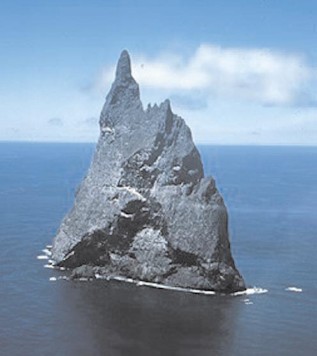Bugs on a Pyramid

Lord Howe Island sits roughly 370 miles off the eastern coast of Australia. It’s one of the strangest places on the planet, mostly due to the fact that it was uninhabited until 1834 (and, in fact, not even discovered until 1788). At just over 20 square miles, the island still retains a lot of its unique quriks. Only about 350 people live there. Tourism is limited to 400 visitors at a time (although not strictly enforced). Non-indigenous plants are outlawed. Most industry which would cause a notable environmental impact — think mining, logging — is restricted to the point of being unheard of. And there are only a half-dozen roads, with a speed limit of 15 kilometers (9+ miles) per hour.
Why?
To protect the species native to the island. At least thirteen different species of bird were native and unique to Lord Howe Island; only four still remain. Dozens of species of plant and insect life are — or in many cases, were — endemic to the island. One bug in particular, the Lord Howe Stick Insect (pictured here), was entirely eradicated from the island and, it was widely believed, the world by 1930.
“Believed,” of course, being the critical word. Nearby the island — 13 miles south — is Ball’s Pyramid, pictured above. Ball’s Pyramid is an eroded reminant of a volcano called a “volcanic stack,” the world’s talest. It’s only 3,600 feet at its longest point and 1,000 feet at its widest, but strikingly, it is over 1,800 feet tall — 400 feet taller than the Empire State Building. Being, in essense, a big piece of rock, it’s not very friendly to life; only a few errant shrubs are believed to live on it.
Yet a 2001 expedition to chart the fauna on the rock turned up something incredible: two dozen stick insects living under a bush. The fact that it survive is a minor miracle, given the location of the Pyramid, it’s relative inhospitableness to life, etc. Since then, researchers have managed to breed the bug, successfully growing the population twenty-fold. (It’s a huge gain, but for context’s sake, the Stick Insect is still the rarest known insect in the world.)
In 2008, twenty representative bugs were returned to Lord Howe Island, in a special habitat, in hopes of rebuilding their population in the wild.
Bonus fact: One of the fungii native to Lord Howe Island (although not unique to it) is omphalotus nidiformis, or the “ghost fungus.” It, as seen here, glows in the dark.
Related: Ball pyramid, no bugs.

Leave a comment